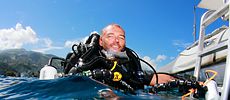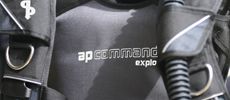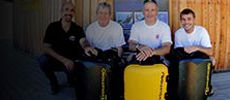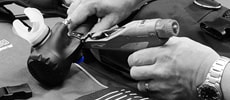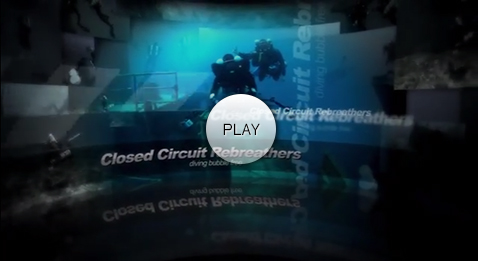THERE’S DIVING.
THEN THERE’S CCR.Are you ready for the greatest dive innovation since Cousteau's aqualung?
Inspiration CCRs open up incredible new worlds for skilled divers… allowing you to dive silently amongst the wildlife and explore further, for longer, in greater comfort. From reef to cave, shore to deep wreck… the advantages are dramatic.
Photo by Greg Regnier
CCR ADVANTAGES
AT-A-GLANCE
- Dive Deeper - the optimum nitrox mix at every depth
- Stay Longer - with dramatically increased No-Deco bottom times
- Greatly Reduced Deco - if you do incur penalties, O2 rich Deco gets you out of the water quicker
- Extreme Low Gas Use - consumption is governed by metabolism not depth, so average use is only about 1 litre/min!
- Greater Comfort - with warm, moist breathing gas
- Versatility - out-of-the-box unit ready to go, shallow or deep
- No Expensive Gas-mixing or Pre-planning - for a target depth
- Perfect Buoyancy Control - unaffected by breathing
- No Bubbles, Silent Diving - get up really close to the wild-life
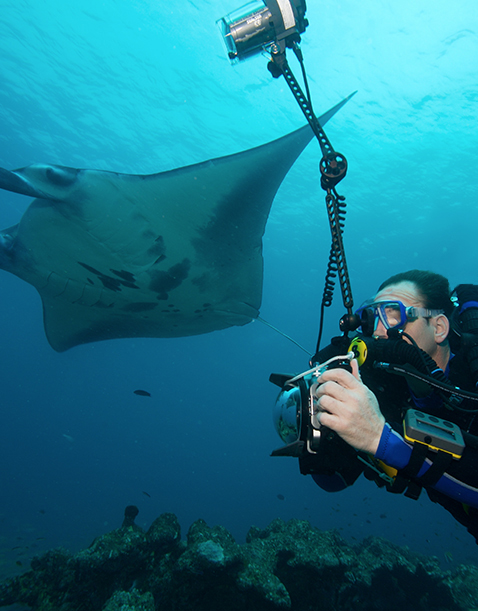
DO NOT DISTURB
Why make the move to CCR? #1
Silent Diving.
You’re no longer an intruder or noisy spectator - you’re a natural part of the sealife around you. Closed circuit rebreathers give you the freedom and time to dive the way you always dreamt.
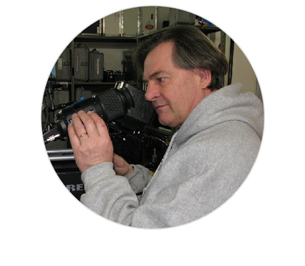
As an underwater cameraman… the basic reasons that I switched from heavy dual tanks to a nice light rebreather unit like [the Inspiration evo] are… simplicity, quietness… I can stay down longer… It gives me 100% humidified gas… It is just wonderful for gas consumption… there’s no up and down movement when I breathe… and small animals in the ocean totally ignore me… like I’m one of the rocks!
Jim Kozmik (Assoc. Producer Sport Diver TV) kozmikunderwater.com
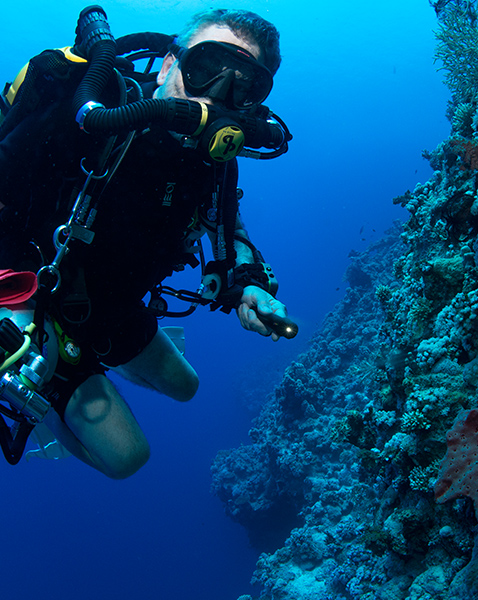
TAKE YOUR TIME
Why make the move to CCR? #2
More dive time.
AP CCRs significantly extend no-stop times. Down to 30m, dive times without incurring deco are typically double the times on open circuit.
The significance of diving with an oxygen-rich breathing gas is that the percentage of inert gas is considerably lower. Consequently, the time allowed to dive before decompression is required – no-stop time – is dramatically increased.
At air-range depths these benefits are huge. Want to take your time on a reef? 3 hours at 20m with no deco is a realistic dive with the Inspiration xpd or evp (or about 2.5 hours with the Inspiration evo - due to the smaller scrubber unit) compared to just 36 minutes on open circuit.
LOOK DEEPER
Why make the move to CCR? #3
Super-Nitrox Diving.
Mixing super-nitrox on the fly - the Inspiration delivers the optimum oxygen-rich mix throughout the dive. The Inspiration offers all of the increased depth, time and deco advantages of open circuit nitrox diving but without the expense, time and hassle of pre-mixing multiple gases for pre-planned target depths, excessive cylinder carrying or gas-switching during the dive.
Inspiration CCRs offer simplified mix gas diving. The oxygen controller maintains a Constant Partial Pressure of Oxygen (PO2) in the breathing loop and thereby delivers a variable fraction of oxygen (FO2) at every depth.
In practice this gives you ultimate versatility: from shallow reef to deep wreck, the same prepped unit will automatically deliver the optimum mix at every depth and a super-O2-rich mix during deco.
|
LESS HANG TIME
|
LESS HANG TIME
Why make the move to CCR? #4
Reduced Deco.
If you do stay down long enough to incur deco penalties, these obligations are greatly reduced. With super-nitrox - delivering the optimum oxygen-rich mix at every depth throughout the dive and an increasingly super oxygen-rich mix at deco depths, the Inspiration gets you out of the water much much quicker than the open circuit guys.
To give just one example: A dive to 30m for an hour will incur only 11 minutes stop time. If you were to do the same dive on open circuit Air, which is very unlikely, but... if you did... you would incur about 74 minutes deco!
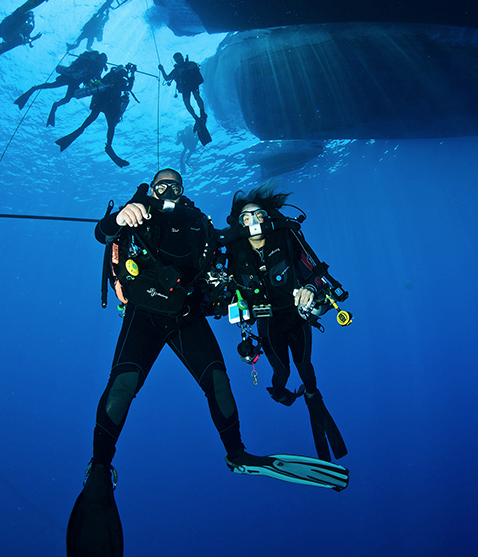
CUT YOUR GAS BILL
Why make the move to CCR? #5
Use a lot less gas.
One of the most significant advantages of fully closed circuit diving is the massive increase in gas efficiency, with smaller cylinders, less visits to the filling station and cheaper fills (particularly when using Trimix)…
Open circuit SCUBA (air or mixed gas) is extremely wasteful of gas. This waste increases dramatically with depth.
At 30m a typical open circuit diver breathes at the rate of 100 litres per minute: 98.9% of which is just volume make-up and is simply bubbled away – every minute!
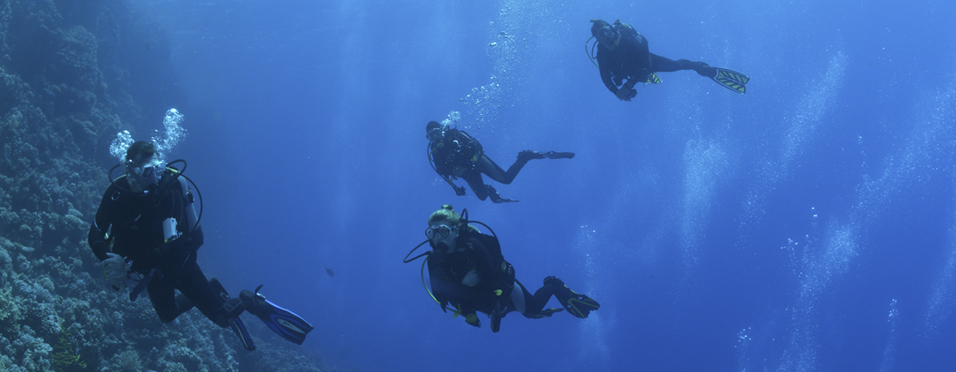
"...10 hours diving from each Inspiration 3 litre gas fill!'
In contrast, the AP INSPIRATION CCR diver's breathing volume normally only needs to be made up once (compensating for squeeze with gas from the diluent cylinder) and metabolised oxygen replaced as the dive progresses (average metabolic consumption = about 1 litre/min) - reducing the gas demands to a fraction of open circuit levels.
Typical consumption for an INSPIRATION diver is about 30 bar per cylinder per dive.
The INSPIRATION xpd's 3 litre onboard oxygen cylinder charged to 200 bar will provide: 3 x 200 = 600 litres O2.
At the average consumption rate of 1 litre/min - this offers about 600 minutes or 10 hours of diving from each INSPIRATION 3 litre gas fill.
HOW REBREATHERS WORK: PART 1
The Closed Circuit
Recycle - Replenish - Re-use
As an experienced open circuit diver, you’ll be very aware that the bulk of your gas is lost, bubbled away, every time you breathe out and that this waste increases dramatically, the deeper you go. With fully closed circuit rebreathers like the AP Inspiration, all of your exhaled gas is retained within the system in a closed loop. It is then filtered, refreshed and recycled back to you to breathe again. Bubbles escape only during ascent and mask clearing.
HOW REBREATHERS WORK: PART 2
The Constant PO2 Setpoint
– elegant gas mixing on the fly
Diving an AP rebreather is essentially like diving with a small nitrox blending machine on your back - one that constantly produces the best gas for whatever depth you are at. How does it do this? By using the elegant mechanism of Constant PO2.
On open circuit scuba the gas mix, or fraction of Oxygen, is constant (approx. 21% O2 in air) at all depths while the partial pressure of Oxygen (ppO2 or PO2) is variable with depth – i.e. 0.21 bar at the surface, 0.42 at 10m, 0.63 at 20m and so on.
With APD CCRs it is the opposite case: the PO2 is held constant (at a Setpoint) by the rebreather controller and consequently the mix or fraction (FO2) of oxygen is variable as the diver changes depth. How so? Read on...
The AP controller maintains a constant PO2 at the chosen PO2 Setpoint throughout the dive (usually 0.7bar at the surface and for descent and 1.3 for the rest) by adding a fresh squirt of oxygen when the pressure of O2 falls below this setpoint (due to metabolism by the diver or when ascending). As a result, the FO2 (or O2 percentage) varies with depth.
This can be better understood if you imagine a diver ascending from 50m…
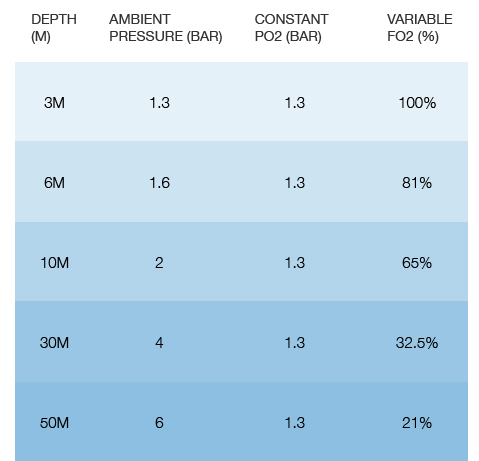
At 50m the ambient pressure is 6 bar. The controller maintains the PO2 at the Setpoint of 1.3 bar - therefore, the fraction of oxygen in the loop is 1.3 ÷ 6 = approx. 0.21 or 21%. As the diver ascends the ambient pressure drops, PO2 in the loop falls and oxygen is injected by the controller until the Setpoint is regained. And so, the partial pressure of oxygen (PO2) remains the same but the percentage of oxygen in the mix rises. You can see from the table above that the diver's gas is oxygen-rich at deco depths - 80%+ rising to 100% at 3m - ideal for speedy deco.
Understanding the benefits of high FO2:
Why is oxygen-rich gas the best? Good question, and one most divers will already be familiar with:
In a nutshell… the more oxygen in the mix, the less inert gas (nitrogen, helium) for our bodies to absorb and create deco obligations. And so: Oxygen-rich = more dive-time, greater depth, less deco.
Understanding partial pressure of Oxygen:
PO2 or FO2… Where does the danger lie in terms of Oxygen toxicity? Another good one and the answer is clearly...
It is all about the PO2
After all, you can breathe 100% Oxygen perfectly safely at the surface and above 6m (as they did with early pure O2 rebreathers). Imagine for a second, you are diving with this type of historic kit...
At the surface, with an FO2 of 100% your partial pressure of O2 = 1 bar, i.e. a safe PO2.
The physiological safety band of oxygen pressure for human beings is 0.16 to 1.6 bar.
As you descend (with this fictitious pure oxygen breathing apparatus) the ambient pressure changes. At 1m for example, with this fixed 100% mix your partial pressure of Oxygen is now 1.1 bar. At 2m it increases to 1.2 bar, at 3m = 1.3 bar and so on.
So by the time you reach 6m your PO2 = 1.6. You are still breathing 100% Oxygen but now at 1.6 bar you are entering the danger zone where Oxygen becomes poisonous or Hyperoxic. Alternatively, if you were to go the other way and ascend in a hot-air balloon to over three times the height of Everest - to the point where the ambient pressure drops to 0.16 bar - your 100% Oxygen supply would now be 0.16 PO2 and would start to become Hypoxic. It's all about the PO2 .
Which is why, in CCR training we emphasise "Always know your PO2!". In contrast to open circuit scuba, where we are taught to constantly be aware of how much gas we have left, in CCR, the importance is "What gas? - what PO2 - am I breathing?".
HOW REBREATHERS WORK: PART 3
A Tale of Two Cylinders - The Diluent Gas
The Inspiration is a complex piece of kit - but ingeniously simple at heart. There are two onboard cylinders. One contains pure oxygen, the other a diluent gas - usually Air.*
The diluent gas has several important functions: injected to maintain counterlung volume on descent, compensating for squeeze (injected either automatically via the Auto Diluent Valve (ADV) or manually by the diver if no ADV is fitted); it is also used for BCD and dry-suit inflation. Only small quantities are used – typically 30-40 bar per dive.
As a ‘diluent’ or dilutant, it dilutes the gas mix so that it is safe to breathe at depths greater than 6m. If the rebreather had only pure oxygen in the loop (as some historic designs did) then it would rise to the hyperoxic upper limit of 1.6 bar at 6m. [The physiological safety band of oxygen pressure for human beings is 0.16 to 1.6 bar] Using diluent allows the unit to maintain a safe PO2 (i.e. the unit’s 0.7 bar lower default setpoint) on descent.
The diluent gas also provides an important reserve gas supply for either a "diluent flush"or open circuit bailout if needed.
*NOTE: If Trimix / Heliox is used instead of Air as the diluent supply and modification is made to the bailout contingency, AP CCRs can be dived to depths of 100m+. For Trimix dives it is necessary to pre-mix a diluent that is suitable for the target depth in terms of PO2 and PH2. Although, on these dives there is no increase in deco-free bottom times compared to open circuit, the fact that the breathing mixture is optimised during the ascent reduces dive planning, simplifies the logisitics, reduces the gas cost exponentially, can reduce the deco times and gives the diver the stress-reducing flexibility of extended gas durations.
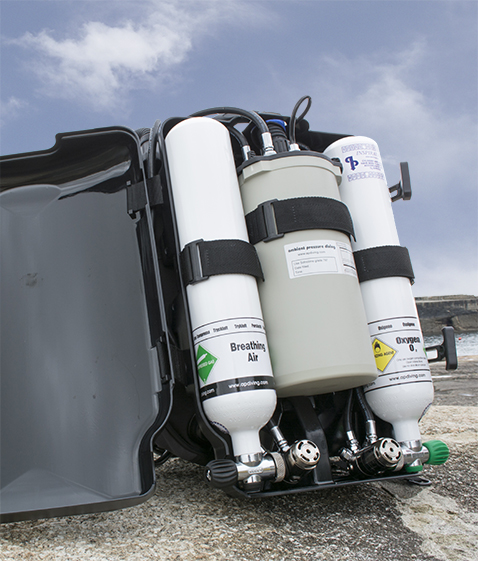
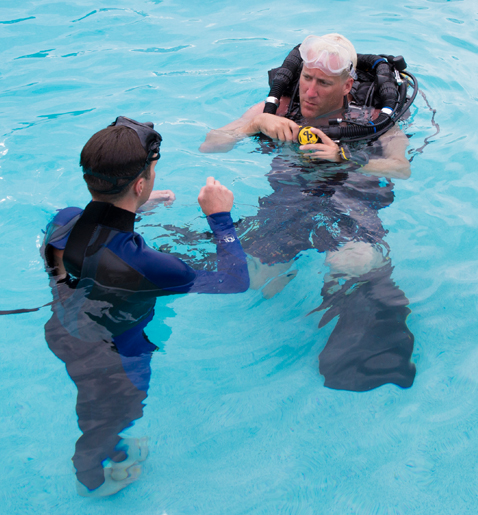
PREPARE TO BE A NOVICE AGAIN
You may be the best open circuit diver since Falco... but with closed circuit, everyone starts off a newbie.
All rebreathers require specialist training before you use them. That’s why AP Diving will only sell rebreathers to divers who are trained and qualified with an AP recognised instructor and agency. No matter how experienced or confident you are on open circuit, you’re starting again with a rebreather - and you’re always learning.
And that’s the point of doing it. To push yourself… to challenge, change and refresh your diving.
BEFORE YOU DIVE DEEPER
Closed circuit diving offers big advantages but it’s not for everyone.
Things you need to consider...
Is it for you? Be honest with yourself about your willingness to:
- Invest the time, energy and money into training and new kit?
- Be prepared to understand that you are a novice again and to learn new things?
- Be self-disciplined enough to learn, practice and re-practice new skills way beyond the initial training course - to turn skills and drills into habit and instinct?
- Be personally disciplined enough to consistently carry out maintenance routines and pre-dive checklists, to be able to “Always Know Your PO2” throughout the dive.
- Build your experience gradually, staying within your training limits?
- Gain a thorough understanding of your rebreather, how it works, how to build it and re-build it?
- Are you the type of diver who allows themselves to become complacent about kit, dive discipline and diving rules over time?
- Are you the type of diver capable of planning ahead, to think through all the possibilities and make provision for them… what could go wrong, what would I need to do?
- Are you the sort of person who skips the instruction manual and looks for the quick-start guide?
- Have you got the networks, buddy divers, boat cover etc with the necessary skills to understand rebreathers and assist you in appropriate ways if required?
- Do the rewards justify the risks for the type of diving you want to do?
- Are you prepared to do the research and source a unit that has been CE certified, i.e. independently tested to meet internationally agreed performance standards
- Are you prepared to do the research to find an instructor with the appropriate experience (and ongoing CCR practice), the reputation and teaching skills to instill what you need to know to keep you alive - not just someone to get you the badge?
Most of the questions above would apply equally well to divers considering moving to the disciplines of technical open circuit diving. Both groups - OC tekkies and rebreather divers - require similar skills and mind-sets and above all, self-discipline.
Do you have it?
These points are reinforced by the Rebreather Education & Safety Association (RESA), of which AP is a founding member. We recommend you view their introduction to CCR film opposite.
LOOKING FOR INSPIRATION?
Some of the world’s most famous divers have pushed the limits of diving achievement with AP Inspiration rebreathers...
It was apparent that the small amount of bottom time we could achieve on open circuit gear would not be worth the effort and the project was put on hold. It wasn’t until 1997, when the first Inspiration CCRs were available that I felt we could extend our bottom time and reduce decompression in the cold North Atlantic water… The Inspiration had used 60 bar of 7/80 and 100 bar of O2 from the two 3 litre inboard cylinders. I wouldn’t even like to think how much open circuit gas we’d have needed to make a 22-minute dive to 158m.
Richard Stevenson on his historic dive on the Carpathia [rescue ship to the Titanic] - Profile: Depth 155m, Bottom time: 18mins, IWT 4 hours, 9 mins.

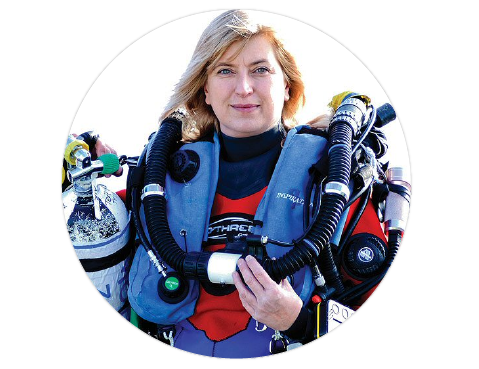
On the Britannic expedition [sister ship to the Titanic, lying in the Kea Channel, Greece] we ran bottom times of up to 48 mins at an average depth of 105m. Filming for National Geographic the in-water time was up to 6 hours… The whole dive, including all the decompression was done on the unit, excluding the gas breaks... and the units performed flawlessly.
I have a very critical view of diving kit. I only add what I think is essential. Having now dived with the Inspiration with Vision electronics, I must tell you they are brilliant and essential. The jump from open circuit to rebreathers was dramatic. The jump to Vision was the same. you should call it Revolution, not Evolution.
Teresa Telus - world renowned technical diver
Divers often ask me why my choice of rebreather. Products that are remarkable get talked about and the Inspiration has to be the most talked about unit on the market. Quite frankly it's brilliant. I certainly talk about mine a lot. Underwater I leave it to do what it does best, look after me and leave me to get on with the dive, with little if any, unnecessary disturbances. Less interruption gives me more time to photograph a shipwreck especially at extreme depth.
AP’s engineering is to diving what Apples engineering is to computing, the best!
What do I like most about the unit? Apart from its intuitive engineering, the fact that straight out-of-the-box you can pretty much do any dive you like with it. Even Titanic's sister ship, the Britannic, that’s exactly what I did! There’s no altering anything, adding anything or switching anything. You just dive it. I wonder if Valentino Rossi can say the same about his Moto GP bikes ? I suspect not.
Leigh Bishop - Deep Wreck Photographer
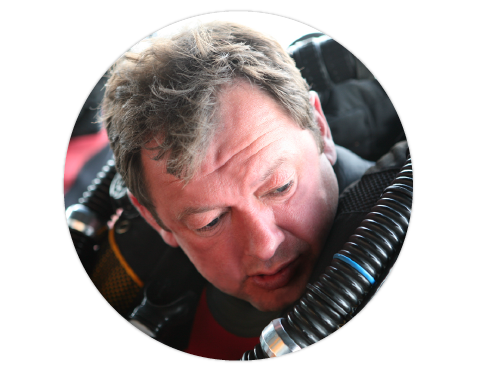
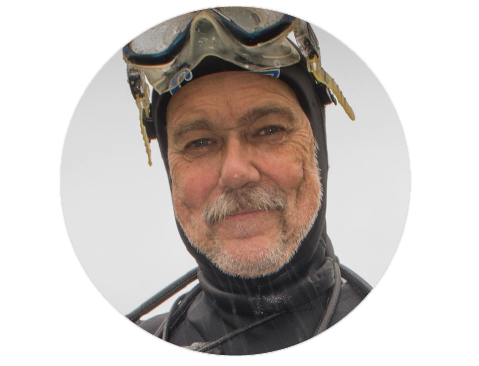
At Cousteau’s Alcyon, a sea-mount that tops out at about 30m, we waited for the air-expelling divers to retreat and the scalloped hammerhead sharks to rise from the depths to be cleaned by willing Barberfish and King Angels… This is the point of coming to Cocos Island to test a new rebreather. Will the unit allow the diver to get close to big animals, and to stay with them for as long as required, without undue technical distractions? These hammerhead sharks provide the evidence - the Inspiration helps turn you into a human fish.
John Bantin, Visionary Evolution - Diver Test Special, 2005

